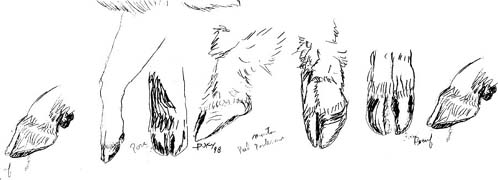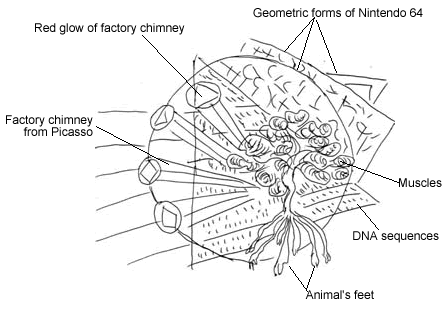|
The meat plant |
|
|
The reality of our information Society is that if one can use their knowledge to imagine a new transgenic lifeform, then molecular biologists with adequate funding, should be able to reduce the abstract concept to life. Invention in a DNA society is essentially reduced to a challenging but solvable engineering problem. Society, especially artists, can influence the direction of scientific advancement by presenting challenging new possibilities to inspire scientists and the institutions in which they work. The meat
Plant is a surrealistic representation of a plant-animal transgenic
chimera, a plant that grows meat. The Meat Plant when reduced to its
most functional level represents the idea that by inserting animal genes,
animal proteins and amino acids could be produced in plants. Recognizing
the essential structural function of roots in sustaining plant life
and their role in absorbing nutrients necessary for growth, Jacques
Deshaies has incorporated animal feet into the roots. Roots with hooved
and clawed feet of farms animals symbolize the "absorption"
of animal genes into plants, animals, and now DNA, in modern agriculture.
The Meat
Plant is also meant to be experienced on a purely aesthetic level since
the poetic qualities of the bonsai tree formed the basis of the form
and lines of the figurative drawing. On a symbolic level, the bonsai,
patiently pruned to conform to the aesthetic ideals of human society,
reflects the growing capabilities for human intervention into the growth,
characteristics and functions of all life forms.
Jacques
Deshaies, through his association of the Meat Plant with factory walls
and smokestacks, also portrays plants as the factories or bio-reactors
of the future. The factory floor is symbolic of plants as platforms
for gene insertion to produce new products. Powered by the sun, these
photosynthesizing hosts for genes from other species will produce a
range of new food and fibres. Inserting human genes into plants will
allow us to pharm plants to produce medicines. Crop production of fuels
and plastics will grow larger over time. The future holds that we won't
just think of plants as just food sources but rather they will produce
a wide variety of industrial products.
Jacques
Deshaies simultaneously frames plants in both a deconstructionist and
holistic manner; from the infinitesimal world of molecules and cells
to the seemingly infinite size of the stars and universe. Post-modern
deconstructionism is represented by the microscopic elements - the spherical
cell, the four cylindrical base pairs of the DNA double helix and the
gene sequencing map. Simultaneously, through these same elements, Jacques
Deshaies considers life from the holistic perspective of the living
planet, Gaia and the Spaceship Earth. We are reminded that there is
harmony between the micro and macro levels of the universe that humans
must respect as stewards of planet Earth. by
Jock Langford, Environnement Canada - Ottawa - June 1998 |
|


